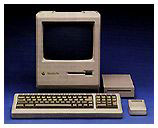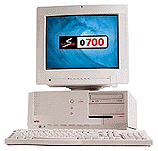Everyone knows about backup, but not everyone does it. And that's a
dangerous thing.
Sure, we're Mac users, so we don't have as many problems with system
crashes that require wiping the whole hard drive as Windows users, but
that's no reason for complacency.
Reasons To Backup
- Your hard drive might die.
- Someone may delete an important file.
- A crucial file could get damaged.
- You might really mess up that document you've been working on. See
Ellen
Feiss.
- Your computer could be stolen or lost in a disaster.
Reasons Not to Backup
- Don't have the time.
- Don't have the right hardware.
- Don't have a backup program.
- Don't remember to do it.
Backup Tales
I've been backing up computers since the days of 5.25" 360K floppy
disks and a 20 MB hard drive on my 8 MHz Zenith PC. It was slow and
time consuming. I didn't do it very often, but I did backup every few
months.
 Ditto with my Mac Plus. It had 800K floppy drives
(two of 'em - one external!) and a 40 MB hard drive. It took a lot of
floppies, but I tried to backup every couple months. It took
forever.
Ditto with my Mac Plus. It had 800K floppy drives
(two of 'em - one external!) and a 40 MB hard drive. It took a lot of
floppies, but I tried to backup every couple months. It took
forever.
And then I got a 44 MB Syquest drive - one quick pass could
duplicate my entire hard drive! Nirvana - until one of the kids stuck a
floppy in the Syquest drive and sheared off a head. Beyond economic
repair.
I moved to a Centris 610
4/80. I bumped RAM to 8 MB, then 12, and later 20. I backed up to a
whole bunch of 1.4 MB floppies. Then I got a 270 MB hard drive, which
was the end of the road for floppy backups.
I bought a Zip drive. Its 100 MB capacity was perfect for backup -
three Zips could hold everything on my 270 MB drive. And when I moved
to a 540 MB drive, a couple more Zips were all I needed. It wasn't
particularly fast, but it beat the heck out of floppies.
 Then came the SuperMac J700 with its 2.1 GB hard drive.
Suddenly 100 MB Zip disks didn't cut it any longer, unless I wanted to
do selective backups.
Then came the SuperMac J700 with its 2.1 GB hard drive.
Suddenly 100 MB Zip disks didn't cut it any longer, unless I wanted to
do selective backups.
Most of this time I'd also been managing backups at my day job. 20,
40, 60, 80 Macs. First on LocalTalk and backed up to a handful of
Syquest cartridges. Later on ethernet and backed up to DAT - and still
later to AIT.
As we began to network computers at home, it was time to do network
backups. Having seen how drive capacity grows, I chose VXA as the ideal solution just over
two years ago. Each tape holds 33 GB uncompressed, and my experience
told me that translates to 45-50 GB of compressed data. The drive was
about $1,300 ($900 today) and the tapes were $80-85 each ($65-70
today), but each tape would last a month or more.
That was a couple years ago. Today we have more Macs with bigger
drives on the network, so our initial backup fills the first tape.
Incremental daily backups have us filling 3 tapes every 2-3 months.
As happens with every backup strategy, as technology marches
forward, we need more and more capacity until we eventually reach the
point where the old backup strategy no longer works. It happened with
floppies and Zips. It happens with high capacity tapes.
Your Backup Needs
There are different ways of doing backup. We do full system backups,
making it possible to fully restore data from a crashed hard drive,
stolen computer, or laptop that met a Diet Coke. We get everything back
from backup: the System Folder with all the preferences, email, work
documents, applications - you name it. It's the best way to do backup,
but it also requires the most backup capacity.
If you're willing to reinstall the Mac OS and your applications, you
might only need to backup your personal files. And you can probably
skip the MP3s, since you can always rip them again. (You do own the
CDs, don't you?)
Backup Software
Cheap and Simple Backup
The simplest backup is to drag the files you want to backup to some
type of external drive or removable media. Whether this is an iPod,
hard drive, CD burner, or Zip drive doesn't matter too much. Some
devices are faster than others, but unless you're saving a lot of data
at once, the process shouldn't be too slow. Those with a .mac account
can even backup 100 MB to their iDisk (albeit at a rate limited by your
Internet connection).
Better Simple Backup
When the Mac OS copies files and folders, it copies all of them -
even if they're already on the other drive. Stupid but true. Over the
years, solutions such as CopyDoubler, Speed
Doubler, and
Copy Agent have allowed Mac users to speed up the process by only
copying files that had changed. If you're using the classic Mac OS,
Copy Agent is worth its weight in gold. (I don't know of a similar
program for Mac OS X. This is one area I will have to research as
I make my slow transition to Apple's next generation OS.)*
Instead of the very simple backup, I strongly recommend a program
with intelligent file copying - as long as you're not backing up to CD.
If you're doing a backup to CD, it really doesn't matter. The OS will
write the whole CD. Not good. (See A
Pox on CD Burning for more on this subject.)
Smarter Backup
The best solution is a backup program, and there are several
available for the Classic Mac OS as well as OS X. I'm not going to
make any specific recommendations, because I've been using Retrospect for too many years to even look
at alternatives.** Retrospect supports both local and network backup of
Macs (classic and OS X), Windows PCs, Linux computers, and Solaris
machines. It's not cheap, but it's worth every penny.
That said, Retrospect is an industrial strength solution. While it
works well for those who know it, it has never been a particularly user
friendly solution. You really should read and reread the manual when
you get started - then come back to it in a few weeks after you've been
using the program. There's a lot of power, and it comes with a somewhat
steep learning curve. And if you want to become a real Retrospect power
user, join the Retro-Talk email
list.
If you've got just one or two Macs, your best bet is probably a
personal backup program, such as the backup option in .mac (Mac
OS X only) or the regular (non-network) version of Retrospect.
Backup Hardware
CDs
Backing up to CD can be cheap, especially if your Mac already has a
CD burner. Blank media is cheap, and if you've already got the drive,
all you need to add is software.
I have no love for CDs as backup media. They're slow and
inefficient, even if you have a very fast CD burner. The 4x and 8x
burners Apple traditionally uses do not qualify as fast. If you plan on
doing comprehensive backups to CD, consider a much faster CD
burner.
Zips and MO Drives
Zip disks and magneto-optical disks are true random access media
designed to handle computer data efficiently. Nowhere near as cheap as
using a CD burner you already own or buying blank CD-R media, these are
also much faster. Due to capacity, I'd lean toward an MO drive instead
of Zip.
Tape
Tape backup used to make a lot of sense. Drives were expensive, but
they were also fast, and tape was cheap. Of the tape solutions on the
market today, VXA seems to find the sweet spot between price (roughly
$900 for an external FireWire drive, $600 for an internal IDE drive,
$65 per 33 GB tape), speed, and capacity. The newer VXA-2 looks to be
an even better deal at $95-100 for an 80 GB (uncompressed capacity)
tape.
Hard Drives
One reason Apple switched from SCSI drives to IDE was cost. Today's
UltraATA hard drives can be incredible values. A
search of recent listings on DealMac finds:
- 80 GB 5400 rpm Western Digital UltraATA/100, $80
- 80 GB 7200 rpm Maxtor, $80 after rebate
- 80 GB 7200 rpm Western Digital UltraATA/100, $103
- 120 GB 7200 rpm Western Digital UltraATA/100, $158
- 120 GB 5400 rpm Maxtor UltraATA/133, $141
- 60 GB 7200 rpm Maxtor UltraATA/100, $60 after rebate
Compare $1.00 to $1.32 per megabyte for a bare drive with
$1.20-1.25/MB for VXA-2 tapes. Then figure that you don't have to buy a
$600-plus tape drive. External FireWire enclosures for 3.5" IDE drives
are available for as
little as $60 (two drive bays, two FireWire ports, and the famous
Oxford 911 bridge). And it's not hard swapping drives out of most
FireWire enclosures, making this a real alternative to tape with
unlimited expandability.
Cost to Switch
Instead of investing more money in VXA tapes, I'm updating
Retrospect (version 5 supports OS X), picking up a couple FireWire
enclosures, a FireWire PCI card (my SuperMac doesn't have built-in
FireWire), and some low cost, high capacity hard drives. Once a drive
is full, Retrospect can use a second drive. You could even unmount and
unplug the full drive from your Mac, remove the drive mechanism from
the FireWire enclosure, install your next drive, and hook it back to
your Mac.
Breakdown of costs:
- Retrospect Desktop upgrade, $93 shipped from MacMall
- Two dual-bay FireWire enclosures, $130 from Computer Geeks
- FireWire PCI card, undecided, $20-50 total cost
- Two 80 GB hard drive, $170 including sales tax at CompUSA
Total cost should come in at $415-445. I hope to sell my old VXA
drive with three tapes and a SCSI cable for about $500, so I'm actually
putting money in my pocket by switching systems if I can get my asking
price. (Low End Mac really is about value computing....)
In terms of speed, this should outperform any other option, and with
today's drive prices, this is also one of the lowest cost ways to
backup a lot of data - and it's far more convenient than dozens upon
dozens of CD swaps.
The Ultimate Solution?
For light use, backing up to CD-R might be the best solution, but as
you get to the point where you're backing up several GB of data,
backing up to an external FireWire drive becomes a more attractive
option.
Also, if you've got more than two Macs, a network solution such an
Retrospect merits serious consideration. The backup server (I use my
old SuperMac J700 for the task) can run 24/7 and check the network,
making sure to back up your 'Book as soon as you return from a
trip.
The combination of networked Retrospect and low-cost hard drives in
FireWire enclosures looks like the best choice in a situation where
several networked Macs are being backed up.
Best of all, network backup can proceed unattended until you need to
change disks or tapes, so you don't even have to remember to run the
software.

 Ditto with my
Ditto with my  Then came the
Then came the 
